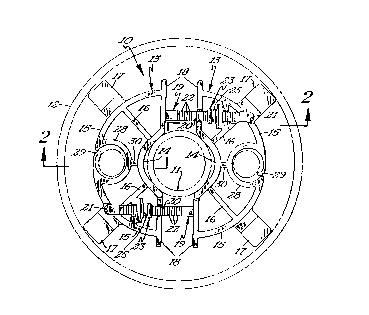Some of the information on this Web page has been provided by external sources. The Government of Canada is not responsible for the accuracy, reliability or currency of the information supplied by external sources. Users wishing to rely upon this information should consult directly with the source of the information. Content provided by external sources is not subject to official languages, privacy and accessibility requirements.
Any discrepancies in the text and image of the Claims and Abstract are due to differing posting times. Text of the Claims and Abstract are posted:
| (12) Patent: | (11) CA 2125354 |
|---|---|
| (54) English Title: | GUARD DEVICE |
| (54) French Title: | DISPOSITIF DE PROTECTION |
| Status: | Term Expired - Post Grant Beyond Limit |
| (51) International Patent Classification (IPC): |
|
|---|---|
| (72) Inventors : |
|
| (73) Owners : |
|
| (71) Applicants : |
|
| (74) Agent: | MACRAE & CO. |
| (74) Associate agent: | |
| (45) Issued: | 1998-01-20 |
| (22) Filed Date: | 1994-06-07 |
| (41) Open to Public Inspection: | 1995-09-19 |
| Examination requested: | 1994-07-18 |
| Availability of licence: | N/A |
| Dedicated to the Public: | N/A |
| (25) Language of filing: | English |
| Patent Cooperation Treaty (PCT): | No |
|---|
| (30) Application Priority Data: | ||||||
|---|---|---|---|---|---|---|
|
A guard device for use with a drop pipe in a well
casing includes a pair of similar guard sections each
being formed of a plastic material. Each section
includes inner and outer arcuate members interconnected
by ribs and plates. The inner arcuate member of each
section engages the drop pipe and the outer arcuate
member has tabs which engage the well casing to enter the
drop pipe. A locking member on each section interlocks
with a lock engaging member on the other section.
Vertical passages through the sections accommodate
electrical conductors, safety ropes and similar
components to thereby minimize damage to these
components.
Protecteur utilisé avec une colonne descendante dans le tubage d'un puits comprenant deux sections protectrices similaires fabriquées d'une matière plastique. Chaque section inclut des éléments intérieur et extérieur arrondis reliés par des nervures et des plaques. L'élément arrondi intérieur de chaque section s'engage dans la colonne descendante et l'élément arrondi extérieur comporte des griffes qui s'engage dans le tubage de puits pour entrer dans la colonne descendante. Un mécanisme de blocage sur chaque section s'enclenche dans une partie d'engagement par blocage dans l'autre section. Des passages verticaux dans les sections reçoivent les conducteurs électriques, les câbles de sécurité et les autres pièces semblables pour minimiser ainsi les dommages à ces composants.
Note: Claims are shown in the official language in which they were submitted.
Note: Descriptions are shown in the official language in which they were submitted.

2024-08-01:As part of the Next Generation Patents (NGP) transition, the Canadian Patents Database (CPD) now contains a more detailed Event History, which replicates the Event Log of our new back-office solution.
Please note that "Inactive:" events refers to events no longer in use in our new back-office solution.
For a clearer understanding of the status of the application/patent presented on this page, the site Disclaimer , as well as the definitions for Patent , Event History , Maintenance Fee and Payment History should be consulted.
| Description | Date |
|---|---|
| Inactive: Expired (new Act pat) | 2014-06-07 |
| Letter Sent | 2009-06-02 |
| Small Entity Declaration Determined Compliant | 2008-04-23 |
| Inactive: Office letter | 2003-07-14 |
| Inactive: Reversal of will be deemed expired status | 2003-07-14 |
| Letter Sent | 2003-06-09 |
| Grant by Issuance | 1998-01-20 |
| Inactive: Application prosecuted on TS as of Log entry date | 1997-11-14 |
| Inactive: Status info is complete as of Log entry date | 1997-11-14 |
| Pre-grant | 1997-10-03 |
| Notice of Allowance is Issued | 1997-04-22 |
| Application Published (Open to Public Inspection) | 1995-09-19 |
| All Requirements for Examination Determined Compliant | 1994-07-18 |
| Request for Examination Requirements Determined Compliant | 1994-07-18 |
There is no abandonment history.
| Fee Type | Anniversary Year | Due Date | Paid Date |
|---|---|---|---|
| Final fee - small | 1997-10-03 | ||
| MF (patent, 4th anniv.) - small | 1998-06-08 | 1998-05-27 | |
| MF (patent, 5th anniv.) - small | 1999-06-07 | 1999-06-03 | |
| MF (patent, 6th anniv.) - small | 2000-06-07 | 2000-05-24 | |
| MF (patent, 7th anniv.) - small | 2001-06-07 | 2001-04-23 | |
| MF (patent, 8th anniv.) - small | 2002-06-07 | 2002-05-13 | |
| MF (patent, 9th anniv.) - small | 2003-06-09 | 2003-05-28 | |
| MF (patent, 10th anniv.) - small | 2004-06-07 | 2004-04-23 | |
| MF (patent, 11th anniv.) - small | 2005-06-07 | 2005-04-11 | |
| MF (patent, 12th anniv.) - small | 2006-06-07 | 2006-04-24 | |
| MF (patent, 13th anniv.) - small | 2007-06-07 | 2007-05-02 | |
| MF (patent, 14th anniv.) - small | 2008-06-09 | 2008-04-23 | |
| Registration of a document | 2008-09-15 | ||
| MF (patent, 15th anniv.) - standard | 2009-06-08 | 2009-05-27 | |
| MF (patent, 16th anniv.) - small | 2010-06-07 | 2010-05-20 | |
| MF (patent, 17th anniv.) - small | 2011-06-07 | 2011-05-10 | |
| MF (patent, 18th anniv.) - small | 2012-06-07 | 2012-04-23 | |
| MF (patent, 19th anniv.) - small | 2013-06-07 | 2013-05-10 |
Note: Records showing the ownership history in alphabetical order.
| Current Owners on Record |
|---|
| CAMPBELL MANUFACTURING, LLC |
| Past Owners on Record |
|---|
| ROBERT N. FARRARA |